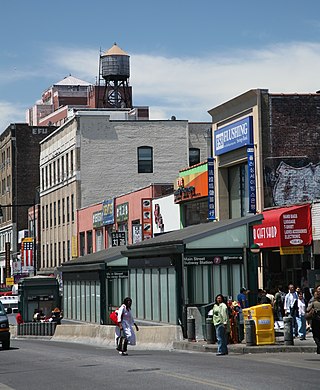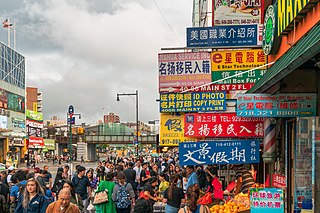
American Chinese cuisine is a cuisine derived from Chinese cuisine that was developed by Chinese Americans. The dishes served in many North American Chinese restaurants are adapted to American tastes and often differ significantly from those found in China.

Chinatown is the catch-all name for an ethnic enclave of Chinese people located outside Greater China, most often in an urban setting. Areas known as "Chinatown" exist throughout the world, including Europe, Asia, Africa, Oceania, and the Americas.

Flushing is a neighborhood in the north-central portion of the New York City borough of Queens. The neighborhood is the fourth-largest central business district in New York City. Downtown Flushing is a major commercial and retail area, and the intersection of Main Street and Roosevelt Avenue at its core is the third-busiest in New York City, behind Times Square and Herald Square.

Friendly's is a restaurant chain on the East Coast of the United States. The first location, selling ice cream cones, was in Springfield, Massachusetts, opened in 1935. It was founded by brothers S. Prestley Blake and Curtis Blake. It has 10,000 employees. George Michel is the CEO. It offers diner-style cuisine and highlights its 22 ice cream flavors. Many locations offer an ice-cream only take-out window alongside of the table service option. Friendly's restaurants are found in Massachusetts, Delaware, Maryland, New Jersey, New York, and Pennsylvania. Its ice cream is also sold in some East Coast supermarkets.

Ruth Reichl, is an American chef, food writer and editor. In addition to two decades as a food critic, mainly spent at the Los Angeles Times and The New York Times, Reichl has also written cookbooks, memoirs and a novel, and has been co-producer of PBS's Gourmet's Diary of a Foodie, culinary editor for the Modern Library, host of PBS's Gourmet's Adventures With Ruth, and editor-in-chief of Gourmet magazine. She has won six James Beard Foundation Awards.

Romacorp Inc., which does business as Tony Roma's, is an American casual dining chain restaurant specializing in baby back ribs. The first location was established by the founder, Tony Roma, in 1972 in North Miami, Florida. Clint Murchison Jr. purchased a majority stake in the restaurant in 1976, and he and Roma established the jointly owned Roma Corporation. The first international location opened in 1979 in Tokyo, followed by an international expansion with both company-owned stores and franchises. As of 2020, there are over 115 locations on six continents.
Shun Lee Palace is a Chinese restaurant located at 155 East 55th Street, between Lexington Avenue and Third Avenue in Midtown Manhattan in New York City. It claims to be the birthplace of orange beef. It opened in 1971. One year later, Shun Lee Palace's master chef T.T. Wang and partner Michael Tong opened Hunan Restaurant at 845 Second Avenue, the first Hunan restaurant in the country, paving the road for others.
The Pelita Nasi Kandar is the largest nasi kandar restaurant chain in Malaysia. Its main headquarters is in Taman Chai Leng, Perai, Penang. The parent company also owns several hotels.

Joe's Shanghai is a chain of seven Shanghainese restaurants in the United States and Japan. The original location was opened by restaurateur Mei Ping "Barbara" Matsumura and chef Kiu Sang "Joe" Si in 1995 in Flushing, Queens, followed by branches in Manhattan Chinatown and Midtown Manhattan. There are four locations in Japan, two in Tokyo, one in Osaka and one in Sendai. Ms. Matsumura has opened over a dozen restaurants in the New York City area, including the popular Haru sushi chain, while Chef Si also opened Joe's Ginger one block from the Manhattan Chinatown location of Joe's Shanghai, building on the original concept but incorporating the influence of other Chinese cuisines, most notably from Hong Kong.

Xi'an Famous Foods is a chain of fast casual restaurants based in New York City that serves Shaanxi cuisine. Xi’an Famous Foods, a family-run business with no outside investors, was founded in 2005. It has been featured in television shows such as the Cooking Channel’s Food(ography), Kelly Choi’s Eat Out NY, and Anthony Bourdain’s No Reservations. It has also appeared in The New York Times, New York Magazine, the Wall Street Journal, Forbes, and others. Xi’an Famous Foods has stores in the New York boroughs of Queens, Brooklyn, and Manhattan.
ShopHouse Southeast Asian Kitchen, or simply ShopHouse, was an American restaurant chain specializing in Southeast Asian cuisine. Its name derived from the shophouse, a common building type in urban Southeast Asia. The first ShopHouse opened in September 2011 in Washington, D.C. As of April 2016, there were a total of fourteen ShopHouse locations, in California, Chicago, Maryland, and Washington, D.C. ShopHouse was owned and operated by Chipotle Mexican Grill, and used a similar serving format.

Chinatowns are enclaves of Chinese people outside of China. The first Chinatown in the United States was San Francisco's Chinatown in 1848, and many other Chinatowns were established in the 19th century by the Chinese diaspora on the West Coast. By 1875, Chinatowns had emerged in eastern cities such as New York City, Boston, Pittsburgh, and Philadelphia. The Chinese Exclusion Act of 1882 barred Chinese immigration to the United States, but the Magnuson Act of 1943 repealed it, and the population of Chinatowns began to rise again.

Koreatown, Queens, in the New York City borough of Queens, is one of the largest and fastest-growing ethnic Korean enclaves outside Korea. It is largely oriented around Northern Boulevard.

There are multiple Chinatowns in the borough of Queens in New York City. The original Queens Chinatown emerged in Flushing, initially as a satellite of the original Manhattan Chinatown, before evolving its own identity, surpassing in scale the original Manhattan Chinatown, and subsequently, in turn, spawning its own satellite Chinatowns in Elmhurst, Corona, and eastern Queens. As of 2023, illegal Chinese immigration to New York has accelerated, and its Flushing neighborhood has become the present-day global epicenter receiving Chinese immigration as well as the international control center directing such migration.
Fuzhounese Americans, also known as Hokchew Americans or Fuzhou Americans or imprecisely Fujianese, are Chinese American people of Fuzhou descent, in particular from the Changle district. Many Chinese restaurant workers in the United States are from Fuzhou. There are also a number of undocumented Fuzhounese immigrants in the United States who are smuggled in by groups such as snakeheads.
Elka Gilmore was an American chef and restaurateur. Her San Francisco restaurant, Elka, earned national acclaim. In 1994, she was nominated for the James Beard Foundation Award for Best California Chef.

Nom Wah Tea Parlor, opened in 1920, is the oldest continuously running restaurant in the Chinatown of Manhattan in New York City. The restaurant serves Hong Kong style dim-sum and is currently located at 13 Doyers Street in Manhattan.

Top Burmese is a small chain of restaurants serving Burmese cuisine in the Portland, Oregon metropolitan area, in the United States. Owners Kalvin and Poe Myint started the business in 2019. There are three locations in addition to the original restaurant on 21st Avenue in northwest Portland's Northwest District: Top Burmese Bistro Royale has operated in Beaverton since 2020, Top Burmese Burma Joy opened on 23rd Avenue in the Northwest District in 2021, and Top Burmese Ambassador opened in Hillsboro in 2022. Top Burmese branch off beyond Burmese Cuisine with Old Asia Bistro & Tea House slated to open in Beaverton in 2023.

Garlic and Sapphires: The Secret Life of a Critic in Disguise is a 2005 memoir by Ruth Reichl describing her tenure as restaurant critic for The New York Times. It also includes some recipes and reprints some of Reichl's columns for the Times. The book was received favorably by critics and became a New York Times best seller.
The Chinatown Ice Cream Factory is an ice cream parlor in Chinatown, Manhattan, New York City. The business opened in 1977, and is known for their Asian-inspired ice cream flavors. They have also opened two additional locations, in Flushing and the Lower East Side.













